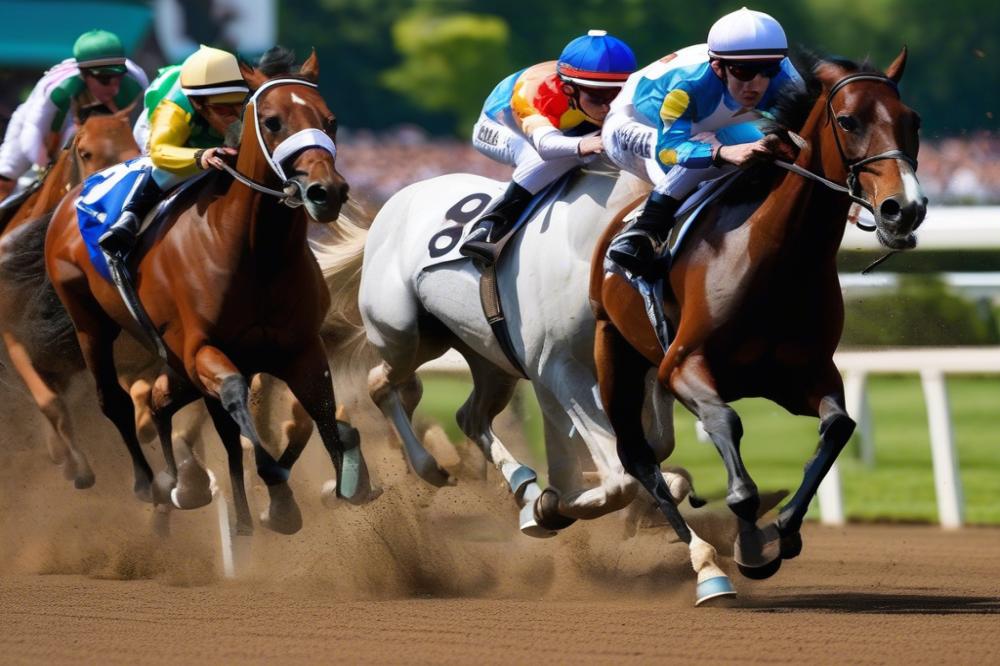Exploring Equine Speed
The world of equine speed captures the imagination of many. Horses have always fascinated humans, particularly when it comes to racing. Various horse breeds dominate this thrilling sport. The allure of speed demons beckons both spectators and aspiring jockeys.
Speed is not merely a measure; it embodies a passion for competition and excellence. In the realm of racing, certain breeds stand out due to their remarkable capabilities. Each breed has a rich history that contributes to its unique characteristics. Understanding these animals gives us insight into their performance on the track.
Fast horses symbolize power, agility, and grace. They often spark rivalries and stories that have become legendary in the racing community. Spectators flock to racetracks, eager to witness the breathtaking events unfold. From the thundering hooves to the breathless finishes, every moment captivates fans.
In this article, we will delve into the fastest horse breeds. These remarkable creatures have redefined the limits of speed. Their journeys to success highlight countless hours of training and dedication. Embracing the spirit of competition, these horses embody what it means to be a speed demon. As we venture deeper, we will uncover the traits that make these breeds so exceptional in their pursuit of supremacy.
Understanding Equine Speed

Equine speed refers to how quickly a horse can move over a certain distance. It plays a critical role in horse racing and competitions. Faster horses can often win more races, making speed a key factor for owners, trainers, and fans alike.
Several elements contribute to the speed of a horse. Genetics holds significant importance. Some breeds have been developed specifically for speed and endurance. These DNA traits are passed down through generations, giving certain horses a natural advantage on the track.
Physical attributes also play a vital role. Strong legs and a solid bone structure help a horse achieve higher speeds. Muscles need to be well-developed, providing the power to sprint. A sleek body shape can enhance aerodynamics, allowing a horse to glide through the air more effectively.
Training is crucial in developing these natural gifts. A horse must undergo a rigorous regimen to maximize its potential. Proper conditioning can improve muscle strength and cardiovascular endurance. Trainers focus on a combination of exercise, diet, and rest to maintain peak performance.
The psychology of a horse contributes to speed as well. A confident and willing horse is often faster than one that is hesitant or fearful. Understanding how each horse reacts to various situations is key for trainers and jockeys. They strive to create an environment that fosters confidence and drive.
Race conditions can influence outcomes, too. Tracks might differ in surface and layout. Weather plays a role, as rain or mud can slow down even the fastest racers. Athletes must adapt and push through these factors, which can affect overall performance.
Thoroughbred: The Racehorse Elite

Thoroughbreds are often recognized as some of the most remarkable athletes in the horse world. This breed has a storied history that dates back to the 17th century. Their roots can be traced to the crossbreeding of native English horses with imported Arabian and Barb horses. This unique combination resulted in a breed that is celebrated for its speed, agility, and endurance.
These horses are typically tall and slender, standing between 15.2 and 17 hands high. Their muscular build allows them to excel on the racetrack. A well-bred Thoroughbred has a long neck, deep chest, and strong, powerful legs. Each trait plays a significant role in enhancing their performance during races.
Thoroughbreds have made immense contributions to the sport of horse racing. This breed has been the backbone of the industry, dominating major racing events worldwide. The Kentucky Derby, Preakness Stakes, and Belmont Stakes are just a few of the prestigious races where Thoroughbreds compete.
Some of the most famous racehorses in history are Thoroughbreds. Secretariat, often considered the greatest racehorse of all time, captured the hearts of many with his incredible speed and winning spirit. His record at the Belmont Stakes in 1973 still stands as a testament to the breed’s capabilities.
Another legendary figure is Man o’ War. He won 20 out of 21 races during his career and became a symbol of excellence in the Thoroughbred community. Recent champions like American Pharoah and Justify have continued the legacy, each winning the coveted Triple Crown title.
The impact of Thoroughbreds on horse racing is undeniable. They have drawn crowds, inspired films, and generated significant betting revenue. Beyond their racing prowess, these horses often become breeding stock, passing on their remarkable traits to future generations.
In addition to traditional racing, Thoroughbreds are versatile. Many find new careers in other equestrian disciplines, such as show jumping or dressage. This adaptability showcases their intelligence and trainability, further solidifying their place in the equine world.
Arabian: The Endurance Champion
Arabian horses show remarkable traits that set them apart in the equine world. Their slim, athletic build allows for both speed and extraordinary stamina. Muscles are lean but powerful, providing the energy needed for long distances. A distinctively shaped head and large nostrils optimize breathing, which is crucial for endurance.
Historically, these horses have played a vital role in endurance racing. They have been used by nomadic tribes for centuries, often covering vast terrains under harsh conditions. It is said that they could travel for days without tiring. Their ability to maintain speed over long periods has made them champions in endurance events today.
Adaptability is another trait that stands out. Arabian horses thrive in diverse climates, from arid deserts to lush valleys. Their resilience allows them to perform well in varying terrains, whether it be sand, grass, or rocky paths. Many riders appreciate how these horses adjust to different riding styles and environments, which enhances their appeal.
Training plays a significant role in their development as endurance competitors. Owners often focus on building a strong bond with their horses. This connection encourages teamwork, which can lead to greater performance in races. Riders and trainers alike emphasize consistent training regimens that promote stamina without sacrificing speed.
Moreover, their natural intelligence aids in their training and performance. Arabian horses are known for being alert and trainable, understanding commands quickly. This mental sharpness contributes to their success in endurance competitions. Races can last several hours, and a horse’s focus can make all the difference.
In sum, the Arabian horse stands out for its speed and stamina. Its historical significance in endurance events highlights its abilities. Adaptability and intelligence further demonstrate why this breed continues to excel in challenging conditions. Each Arabian carries a legacy of resilience, making it a well-respected contender in the equine community.
Quarter Horse: The Speedster of Short Distances
The American Quarter Horse stands out as a true star in the realm of equine athletes. Known for its incredible speed in short-distance racing, this breed has captured the hearts of many. Originating in the United States, the Quarter Horse is highly regarded for its ability to run a quarter of a mile faster than any other horse. This distinct talent makes it a favorite in various competitions.
Acceleration is where the Quarter Horse truly shines. These horses can reach top speeds almost instantly, thanks to their powerful muscular build. Their short, compact bodies house strong legs that propel them forward with astonishing quickness. Races that last for just a few hundred yards become thrilling displays of raw power.
In rodeos, Quarter Horses excel at events like barrel racing and roping. Their agility allows them to navigate tight courses quickly, making them ideal for these fast-paced competitions. A rider can feel confident knowing their Quarter Horse will respond with impressive precision. This breed thrives on challenges, which is evident in both competitive and recreational settings.
Many enthusiasts appreciate the Quarter Horse for its versatility. Apart from racing, these animals are also used in various disciplines, including cutting and reining. Their keen intelligence and willingness to work make them a joy to train. With dedication, riders can develop a strong bond with their steeds.
Fans of the breed often highlight its charming temperament. Quarter Horses are known for being friendly and easy to handle. This trait makes them suitable not only for experienced riders but also for beginners. When one looks at this breed, it’s easy to see why they are considered some of the fastest horses around.
Akhal-Teke: The Golden Horse
The Akhal-Teke is a breed renowned for both its exquisite beauty and remarkable speed. Originating from Turkmenistan, it is one of the oldest horse breeds in the world, tracing its roots back thousands of years. These horses have historically been prized by nomadic tribes for their endurance and ability to thrive in harsh environments.
One of the most striking features of the Akhal-Teke is its shiny, sleek coat, which often appears golden or metallic. The unique sheen of their fur gives them a spectacular appearance, making them stand out in any crowd. They possess a long, slender body that contributes to their agility. Many fans of this breed also appreciate their distinctive mane and tail, which are often long and flowing.
In terms of performance, Akhal-Tekes excel in both racing and endurance disciplines. Their strong, muscled build allows them to cover ground efficiently. This breed is known for its incredible stamina, making it a popular choice for long-distance racing. Trainers often praise them for their speed in sprinting events as well.
These horses are also intelligent and adaptable, traits that serve them well in various competitive settings. With proper training, an Akhal-Teke can become a top contender in races. The bond between rider and horse often leads to impressive achievements in competitions.
In summary, the Akhal-Teke is more than just a beautiful horse; it embodies speed and endurance. Their stunning appearance and high performance make them a beloved and respected breed among enthusiasts around the globe.
Mustang: The Wild Speedsters
The Mustang is more than just a horse; it symbolizes freedom and resilience in the American West. Born from horses that escaped or were released by early settlers in the 16th century, these animals developed their own unique identity over time. They roamed freely across vast landscapes, which contributed to their impressive speed and endurance.
Genetic diversity among Mustangs plays a significant role in their ability to adapt to various environments. Different regions in the United States have shaped their characteristics, resulting in a heterogeneous collection of traits within the breed. This adaptability makes them capable of surviving in diverse climates, from arid deserts to grassy plains.
Wild Mustangs can sprint impressively, often reaching speeds of up to 30 miles per hour. This speed allows them to escape predators and travel long distances in search of food and water. As descendants of strong breeds, they carry this ability, making them some of the fastest horses in the wild.
The cultural impact of Mustangs is profound. In American traditions, they represent the spirit of exploration and independence. They have become icons in literature, art, and film, capturing the imaginations of many. Some people even participate in rodeos and horse racing events to showcase their skills.
Mustangs also participate in organized horse racing today, though it’s not as common. Their unpredictable nature and strong instincts can make them thrilling competitors. Recent initiatives aim to increase public interest in these wild horses, emphasizing their importance to America’s heritage.
Beyond racing, these horses have bolstered conservation efforts. Programs designed to protect Mustangs focus on maintaining their populations while balancing ecological needs. By ensuring a healthy environment for these creatures, people can help preserve their legacy for future generations.
Life as a Mustang is challenging, yet they thrive in the wild. Their wild nature fuels their spirit, making them a testament to survival. Speed, stamina, and an adventurous heart define these remarkable animals, showcasing the wonders of equine diversity.
The Importance of Stamina in Racing
Many people might think that speed is all that matters in horse racing. While it’s true that fast horses grab attention, stamina plays an equally crucial role. Races are often more than simple sprints; they can cover long distances. Endurance determines whether a horse can maintain their speed throughout the entire race.
Different horse breeds exhibit distinct balances of speed and stamina. Thoroughbreds, for instance, are known for their impressive bursts of speed. However, they can also display surprising endurance when trained properly. In contrast, Arabian horses are celebrated for their stamina. They tend to not outrun other breeds initially but can sustain a strong pace for much longer.
The dynamics of each race can significantly affect performance outcomes. Weather conditions, track surfaces, and race lengths can all impact how stamina is utilized. A horse trained specifically for sprint races may falter in a longer event. Conversely, a horse that excels in endurance races may struggle in short, fast competitions.
Training plays an essential role in developing both speed and stamina. Trainers focus on building endurance through long, slow workouts while gradually incorporating faster intervals. This method helps horses learn how to conserve energy while still being able to kick it up a notch when needed. Horses that cannot balance these components often underperform in competitions.
Tactics used during a race also highlight the importance of stamina. Jockeys need to know when to push their horses and when to hold back. A well-timed move can make the difference between winning and losing. Horses that can maintain their speed late in a race often come out on top.
In the end, understanding the relationship between speed and stamina is vital for trainers, jockeys, and fans alike. Knowing that these factors work together can change how people view races. A horse that might not seem fast at first can shine in the later stages, showcasing the true essence of racing.
Final Thoughts
The world of equine athletes offers a fascinating glimpse into speed and stamina. Throughout this article, we have explored a range of breeds that excel in racing and sports. Each breed brings its own strengths to the table, showcasing the diversity within the fastest horse breeds on the planet. From the noble Thoroughbred, well-known for its prowess on the racetrack, to the spirited Arabian, prized for its endurance, these horses embody the spirit of competition.
Many of these breeds have significantly influenced the equestrian world. Their exceptional skills have pushed the boundaries of what we thought possible in horse racing and other equine sports. Not only do these animals entertain us, but they also inspire trainers and riders to reach for greater heights.
Moreover, exploring these magnificent creatures opens a door to understanding the bond between horses and humans. Each breed has its own unique story and history that adds richness to our appreciation for them. Ultimately, further exploration of these remarkable animals can deepen our connection to the equine world. Discovering their capabilities can lead to a greater appreciation of their role in both sport and culture.
In short, the fastest horse breeds fascinate us and remind us of the incredible capabilities of animals. Whether you are a fan of racing or simply admire horses, there is always more to learn and admire about these fantastic creatures.



